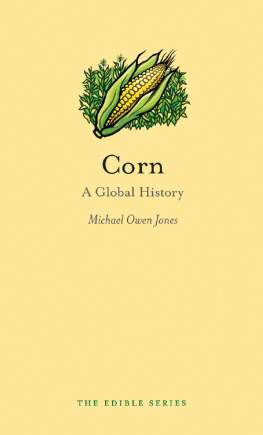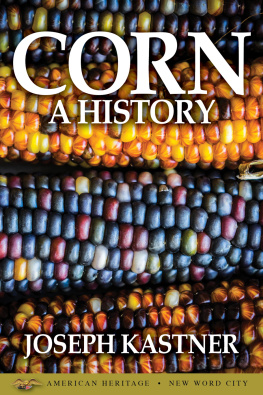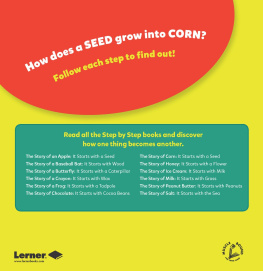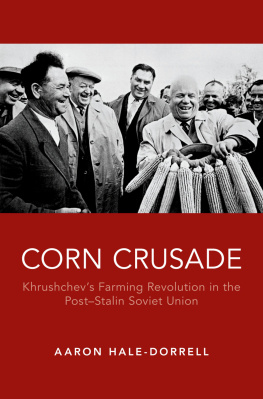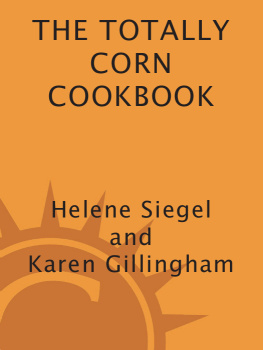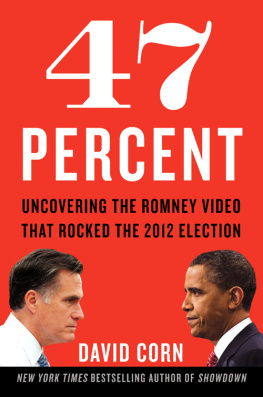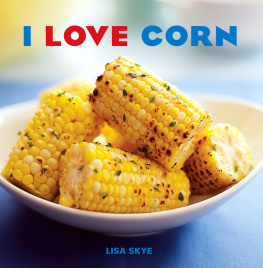CORN

Edible
Series Editor: Andrew F. Smith
EDIBLE is a revolutionary series of books dedicated to food and drink that explores the rich history of cuisine. Each book reveals the global history and culture of one type of food or beverage.
Already published
Apple Erika Janik Banana Lorna Piatti-Farnell
Barbecue Jonathan Deutsch and Megan J. Elias
Beef Lorna Piatti-Farnell Beer Gavin D. Smith
Brandy Becky Sue Epstein Bread William Rubel
Cake Nicola Humble Caviar Nichola Fletcher
Champagne Becky Sue Epstein Cheese Andrew Dalby
Chillies Heather Arndt Anderson Chocolate Sarah Moss
and Alexander Badenoch Cocktails Joseph M. Carlin
Corn Michael Owen Jones Curry Colleen Taylor Sen
Dates Nawal Nasrallah Doughnut Heather Delancey Hunwick
Dumplings Barbara Gallani Edible Flowers Constance L. Kirker
and Mary Newman Eggs Diane Toops Fats Michelle Phillipov
Figs David C. Sutton Game Paula Young Lee Gin Lesley Jacobs
Solmonson Hamburger Andrew F. Smith Herbs Gary Allen
Herring Kathy Hunt Honey Lucy M. Long Hot Dog Bruce Kraig
Ice Cream Laura B. Weiss Lamb Brian Yarvin Lemon Toby Sonneman
Lobster Elisabeth Townsend Melon Sylvia Lovegren Milk Hannah Velten
Moonshine Kevin R. Kosar Mushroom Cynthia D. Bertelsen
Nuts Ken Albala Offal Nina Edwards Olive Fabrizia Lanza
Onions and Garlic Martha Jay Oranges Clarissa Hyman
Oyster Carolyn Tillie Pancake Ken Albala Pasta and Noodles
Kantha Shelke Pie Janet Clarkson Pineapple Kaori OConnor
Pizza Carol Helstosky Pomegranate Damien Stone Pork Katharine
M. Rogers Potato Andrew F. Smith Pudding Jeri Quinzio
Rice Renee Marton Rum Richard Foss Salad Judith Weinraub
Salmon Nicolaas Mink Sandwich Bee Wilson Sauces Maryann Tebben
Sausage Gary Allen Seaweed Kaori OConnor Shrimp Yvette Florio Lane
Soup Janet Clarkson Spices Fred Czarra Sugar Andrew F. Smith
Tea Helen Saberi Tequila Ian Williams Truffle Zachary Nowak
Vodka Patricia Herlihy Water Ian Miller
Whiskey Kevin R. Kosar Wine Marc Millon
Corn
A Global History
Michael Owen Jones
REAKTION BOOKS
Published by Reaktion Books Ltd
Unit 32, Waterside
4448 Wharf Road
London N1 7UX, UK
www.reaktionbooks.co.uk
First published 2017
Copyright Michael Owen Jones 2017
All rights reserved
No part of this publication may be reproduced, stored in a retrieval system, or transmitted, in any form or by any means, electronic, mechanical, photocopying, recording or otherwise, without the prior permission of the publishers
Printed and bound in China by 1010 Printing International Ltd
A catalogue record for this book is available from the British Library
ISBN 978 1 78023 816 6
Contents

Prologue

In the United Kingdom, corn refers to the principal grain crop of a district, such as wheat in England and oats in Scotland and Ireland. The Tano in the Caribbean encountered by Columbus in 1492 used the term mahiz, which the Spanish rendered as maz; it became Anglicized as maize. American colonists and the British called the grain grown by indigenous people in the New World Indian corn.
On 2 January 1766, Benjamin Franklin published a letter in a London newspaper responding to British attacks on American character. A writer had lampooned the colonists, insisting that they lacked the fortitude to continue their boycotts of tea and other imports because their diet of Indian corn failed to provide an agreeable or easily digestible breakfast. Signing himself Homespun, Franklin retorted:
Pray let me, an American, inform the gentleman, who seems ignorant of the matter, that Indian corn, take it for all in all, is one of the most agreeable and wholesome grains in the world; that its green leaves [i.e. young ears] roasted are a delicacy beyond expression; that samp, hominy, succotash, and nokehock, made of it, are so many pleasing varieties; and that johny or hoecake, hot from the fire, is better than a Yorkshire muffin.

Pocahontas Bringing Corn to the Colonists, 1897.
The fare mentioned by Franklin derives from native people. Samp (Algonquin nasamp; or Narragansett nasaump) was porridge made from coarsely ground corn and eaten hot or cold. Nokehock or nokechick was parched corn cooked in hot ashes, then pounded into meal to be boiled or fried and sweetened with maple sugar or syrup. Succotash (from Narragansett meaning broken kernels) was maize boiled together with shell beans. Simply prepared, these dishes were, in Franklins words, wholesome, pleasing and, in regard to fresh corn on the cob, even a delicacy.
Maize was a staple for indigenous populations centuries before Columbus arrived in Hispaniola. Had it not been for the generosity of natives who gave the colonists corn, Jamestown, established in 1607, might not have survived as the first permanent English settlement. Even with the gifts of food, more than 80 per cent of the settlers perished in 160910 after a drought drastically diminished native stores of grain.
Developed in Meso-America thousands of years ago, corn or maize has become a leading grain crop, along with wheat and rice, and a staple globally. It is now grown in 160 countries and the United States has long been the worlds largest producer. Native people in the Americas told origin stories about deities bestowing maize on mankind and even creating human beings from it. The U.S. and countries in Latin America, Africa and Eastern Europe have issued stamps and minted coins depicting corn. Annual festivals and fairs feature the grain. The sports teams at the Hoopeston Area High School in Illinois bear the name Cornjerkers, and the 23 teams at the University of Nebraska are called the Cornhuskers (or simply Huskers). Maize nourishes the cattle, swine and fowl that humans consume. Around the world people eat corn on the cob, turn maize into porridge and bake breads from cornflour or meal. They boil or fry concoctions as savoury or sweet dishes. Distilled or fermented, corn is converted into whiskey or beer.

Nebraska boasts the title the Cornhusker State, corn is the official grain of Wisconsin, and Washington, Missouri, proclaims itself the Corn Cob Pipe Capital of the World.


